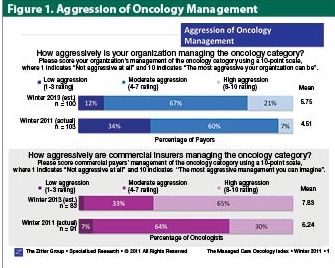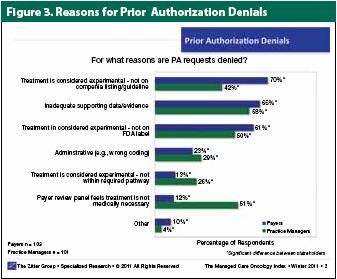Publication
Article
Pharmacy Times
Payer Management of Oncology Gets Serious
Author(s):
A closer look at payer management in oncology reveals trends for both oncologists and payers in this changing environment as health plans continue to seek methods to curtail costs associated with cancer care.
A closer look at payer management in oncology reveals trends for both oncologists and payers in this changing environment as health plans continue to seek methods to curtail costs associated with cancer care.
Analyzing payer management of oncology over the past few years, a major trend has emerged—payers intend to increase their management of the category. Health plans continue to seek methods to curtail the costs associated with cancer care without diminishing the quality of that care. Indeed, both payers and oncologists anticipate significant increases in the aggressiveness of payer oncology management over the next 2 years.
According to the data collected in the most recent edition of The Zitter Group’s Managed Care Oncology Index, just 38% of payers currently feel confident in their organizations’ ability to effectively manage oncology. Although this number represents a significant increase from the 25% who reported such confidence 6 months ago, it is clear that payers have a long way to go to exert extensive control over cancer care.

In anticipation of the expected management increases, oncologists and practice managers indicate a growing resignation to payer influence on oncology practice. However, oncologists also perceive a slight decrease in the level of payer management aggressiveness from 6 months ago. This decline in reported restrictiveness may be due to adaptation by oncologists and practice managers to the policies already in place, as payers do not cite any corroborating changes in policy.
All stakeholders expect the degree of management intensity to ramp up over the next 2 years. Oncologists, however, expect a more dramatic increase than do payers. Sixty-five percent of oncologists expect a high degree of management aggressiveness by 2013, whereas only 21% of payers say they will have highly aggressive management policies in place by then. Oncologists also perceive the current degree of payer oncology management to be significantly more aggressive than payers report. Currently, only 7% of payers report having highly aggressive oncology management policies, whereas 30% of oncologists feel the level of payer management is highly aggressive (Figure 1).
Waste and Excess Cost
As the cost of oncology care continues to rise, increases in management efforts by payers appear to be inevitable. In fact, payers believe that nearly 23% of current costs could be eliminated from the delivery of cancer care without negatively impacting health outcomes. Oncologists and practice managers share similar sentiments, but not to the degree expressed by payers. Oncologists feel 18% of costs can be shaved, whereas practice managers see that number slightly lower, at just below 16% of costs.
Payers perceive the greatest degree of wasteful spending coming from excessive end of life treatment and inappropriate drug utilization. Eightythree percent of payers believe inappropriate drug utilization helps to drive excess cost. The majority of payers define inappropriate utilization as utilization outside a compendialisted use. Conversely, while oncologists believe adherence to compendia improves care, they insist off-label prescribing is critical to providing the best quality care.

Furthermore, 43% of payers see suboptimal distribution of prescription drugs—such as buy and bill versus specialty pharmacy—as a significant driver of excess costs. That said, only 33% of payers currently require drug distribution through a third-party vendor. The number of plans utilizing specialty pharmacy providers (SPPs) and/or pharmacy benefit managers could see a sizable increase as payers attempt to rein in costs without harming care quality.
Distribution Changes Coming
During the next year, payers anticipate shifting infused oncology therapy distribution away from buy and bill in favor of their preferred distribution channel, specialty vendors (Figure 2). Currently, more than 70% of infused therapies for oncology are distributed via buy and bill, with average sales price as the primary method of reimbursement used by payers. Providers have felt the pain: 36% of oncologists and 54% of practice managers report declines in practice revenue since moving to ASP reimbursement. Payers now are looking to SPPs as the next step in minimizing excess reimbursement costs in oncology care.
Already, 30% of practice managers have experienced payer attempts to limit their ability to buy and bill for oncology therapies through contract terms. The majority of these contract terms specified either voluntary or mandatory vendor requirements, eg, specialty pharmacy. This trend has been well established with oral oncology therapy distribution, and payers anticipate a further shift away from off-site retail in favor of the specialty vendor channel for oral distribution over the next year.
Management Through Prior Authorization
Prior authorizations (PAs) remain the most prevalent and impactful management method utilized by payers in oncology management.
Although widely used and shown to impact both oncologist and practice manager prescribing behavior, PAs are not fully achieving payer goals. The primary payer objective for oncology PAs is to limit inappropriate utilization, one of the perceived key drivers of excess costs in cancer care. However, just 19% of payers report having met this objective successfully.

There is significant disparity between payer, oncologist, and practice manager perception as to the impact of oncology PAs. While payers believe their PAs take a provider’s office an average of just 16 minutes to complete, oncologists and practice managers report them taking significantly more time, with average durations of 38 minutes and 50 minutes, respectively. Furthermore, payers report denying 38% of all PA appeals, whereas practice managers report that nearly 9 out of 10 appealed requests are eventually approved. Payers and practice managers also differ greatly when it comes to the perceived reasons for a PA denial. Payers report denying PA requests primarily for treatments not on compendia listings/ guidelines or the FDA label, whereas over half of practice managers report denials arising due to payer perceptions of a lack of medical necessity. Just 12% of payers report the last to be true (Figure 3).
Although there remains a degree of disconnect between payer management policies and their perceived effect on oncology practices, the reality remains that payers are indeed taking a more direct role in oncology management. In their efforts to decrease costs, payers will continue to increase their use of PA requirements, preferred distribution channels, treatment guidelines, clinical pathways, and companion diagnostics. Oncologists and practice managers seem increasingly, if begrudgingly, to accept these management tools as the inevitable evolution of cancer care management. SPT
About the Authors
Michael Snyder is a sales and marketing analyst at The Zitter Group and can be reached at msnyder@zitter.com. He is based in San Francisco, California.
Lee Goldberg, senior manager of syndicated research at The Zitter Group, can be reached at lgoldberg@zitter.com and is based in Millburn, New Jersey.
Tracey Ryan, senior analyst at The Zitter Group, can be reached at tryan@ zitter.com and is also based in Millburn.
All figures and numbers in the article are based on the findings of the Winter 2011 edition of The Zitter Group’s Managed Care Oncology Index (MCOI). The MCOI is a semi-annual, multi-client study surveying approximately 100 payers, 100 oncologists, and 100 oncology practice managers. Started in 2006, the survey explores a wide range of payer oncology management issues, including physician reimbursement, prior authorization, patient cost-sharing, specialty The reality remains that payers pharmacy, site of care dynamics, practice economics, and clinical guidelines.







